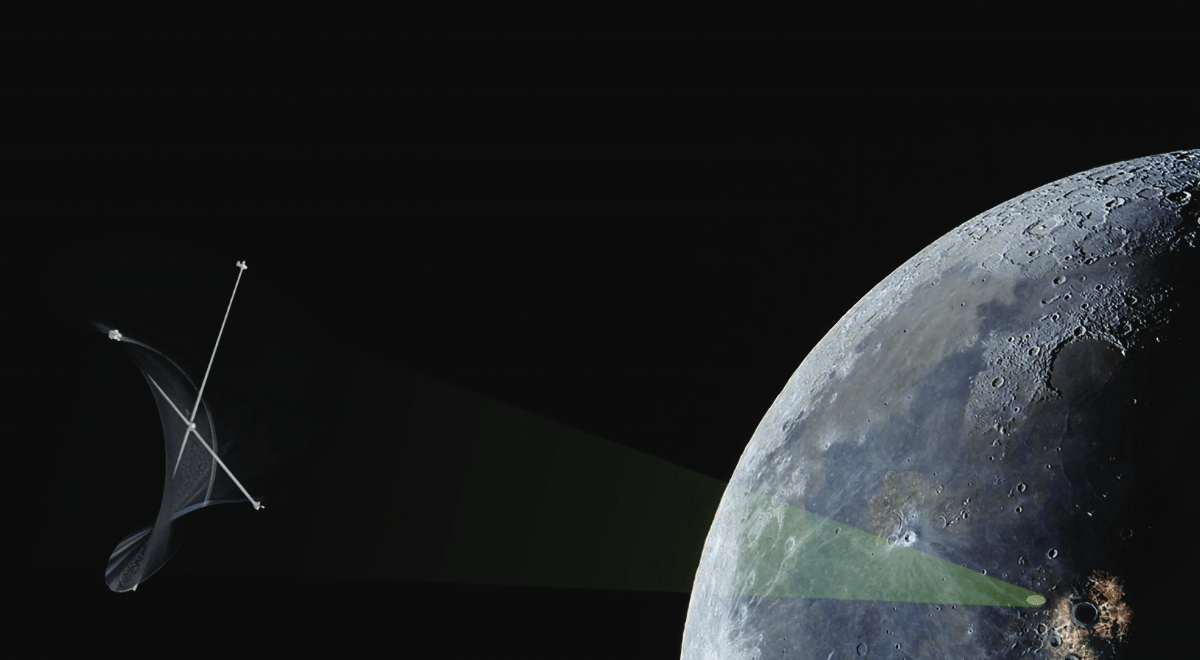The Swiss company Astrostrom has advanced the idea of solar power from space for the moon – in a study carried out from 2021 to 2023 with the support of the European Space Agency (ESA).
Advertisement
At the heart of the plan is the so-called GE⊕-LPS (“Greater Earth Lunar Power Station”), a habitable space station in lunar orbit. It is intended to provide solar energy for the infrastructure of people stationed on the moon. The project was created as part of the ESA campaign “Clean Energy – New Ideas for Solar Power from Space” and is one of almost a dozen. “Most of the required technologies are already in place or under development,” Astrostrom CEO Arthur Woods told MIT Technology Review.
Satellite station captures energy
According to the plan, the space station will have V-shaped solar panels, modeled after butterfly wings but configured in a helix (to collect power as permanently as possible) and hovering 61,350 kilometers above the moon (Lagrange point between moon and earth). The size would be gigantic at one square kilometer. Astrostrom estimates that you could generate more than 20 megawatts of continuous power in this way and then send it to a moon base – later also to earth. Microwaves are to be used to transmit electricity. The transmission system in space would also be huge at 1000 meters × 1174 meters. The receiving station on the moon would even have a diameter of four kilometers.
Since all the necessary material can hardly be transported into space, GE⊕-LPS is to be manufactured largely with raw materials from the moon. This includes iron pyrite, the components of which are found in the lunar regolith and which is to be used for monolayer solar cells. According to the study, the development of such solar cells goes back to researchers from Estonia, whereby the solar cell is based on a semiconductor compound made of microcrystalline powders, which is known by the chemical formula Cu2CdGe(SxSe1-x)4. But silicon and titanium iron are also found on the moon; according to the study, they are intended for the production of electronic components.
The substances that would have to be imported from Earth include potassium fluorine, chlorine and hydrofluoric acid, which do not occur on Earth’s satellite and are required as reagents. According to the study, furnaces, pipes, coolers, pumps, tanks and valve technology are also required. The solar power plant should be designed for permanent human stationing and bring in money thanks to space tourism.
The space elevator thing
Advertisement
If all this is not too futuristic for you, you will be happy about another detail that is in the Astrostrom study: In order to transport the material from the moon to the station, a space elevator is to be built – and later even one from the station to Earth. “Our research has shown that developing a moon-to-earth space elevator has much greater potential to reduce transportation costs and increase capacity than other technologies, including rocket transport and mass transport,” says CEO Woods. The head of the company is obviously aware that this alone is a mega project, but he is hoping for the help of physics. “Manufacturing processes on the lunar surface will benefit from the lower gravity, making it easier to extrapolate terrestrial processes to the moon.” By this he means, among other things, that less powerful cranes are needed to build the industrial plants.
Astrostrom estimates the costs for the implementation at 100 billion euros, which seems comparatively cheap. The most expensive part is the production on the moon, including the necessary mining operations. 15 billion are estimated for the further development of the concept of a satellite solar power plant. When asked what Astrostrom currently makes a living from, Woods says it acts as a think tank for industry, institutions, organizations and individuals. Feasibility studies and visualization projects are carried out. “We are developing specific concepts related to our research that could attract investors.”
Astrostrom does not comment on a concrete implementation, which could take decades. However, the company is hoping for help from the sustainability sector and appropriate subsidies, but it is uncertain whether they will come. The 100 billion euros are said to correspond to only two percent of the costs of the European energy transition. “If our proposed program ramps up in the next few years and enough stakeholders from member countries commit, we are confident that the first Solar Power Satellites, built primarily from lunar materials, could be launched in the late 2030s “, so Astrostrom boss Woods. After the demonstrator works on the moon, the earth could then also be supplied with electricity from space.
(bsc)
To home page
